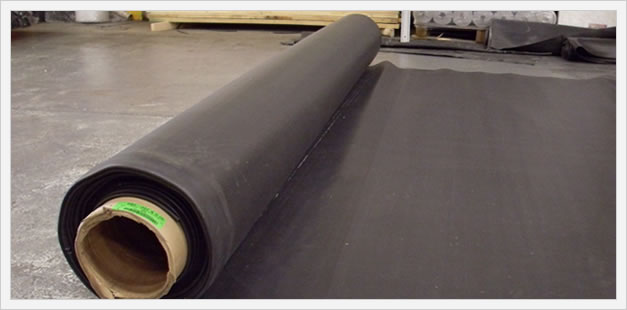
| PROJECT BASICS | PRICES & COSTS | POPULAR MATERIALS | ROOFING STYLES |
Rubber Roof
Rubber roofs aren't always understood by homeowners and are therefore not often the first material that springs to mid. However, these shingles or roofing membranes offer a host of advantages which need to be fully understood before deciding whether this is the best roofing material to use for a specific project. Our rubber roof cost calculator below can help you find a general price point on your next roof replacement or repair.
Rubber Roof Shingles
Rubber roof shingles look similar to any other roofing shingle. The difference is that these are manufactured from a synthetic rubber, which is a somewhat lightweight material. These shingles are easy to cut, which means they can be shaped for certain areas on the roof. When it comes to installation, they are installed the same as other shingles on the market.
Rubber Roof Membranes or Sheets

Rubber roofing membranes are manufactured to fit the shape and size of a particular roof. This is not a cheap option, but it does offer some distinct advantages, including a reduction in roof leaks since there are no seams in the material. Rubber roofing is available in two membrane options; EPDM and IB. These rubber membranes can be quite heavy, which can make installation more difficult. Rubber roofing works very well on smaller or flat roofs.
EPDM Roof Costs
EPDM Membranes can cost between $5 and $8 per square foot, this is the installed price. It works out to around $500 and $800 per square.
-- $5 to $8 fully installed --
More On EPDM Rubber Roofing Costs
IB Roof Costs
IB Membranes can cost between $9 and $11 per square foot installed, working out to between $900 and $1,100 per square.
-- $9 to $11 fully installed --
More On IB Rubber Roof Prices
Rubber Roof Cost Calculator
Our on page rubber roof cost calculator can help you find ballpark project price estimates. The tricky part here is that there are so many rubber roofing options that have varied price ranges: rubber membranes, sheets, EPDM, and IB are all varied in terms of their material and installation cost.
In general, our rubber roof replacement cost estimator uses $5 for materials psf and $2 for removal psf. It then calculates the size of your roof and makes a cost estimation for the type of roofing company that you opt for. Put it all together, and you have a nice ballpark price for your rubber roofing replacement project.
Advantages of a Rubber Roof
Energy Efficiency
Rubber roof materials are very energy efficient and include the ability to manage all types of weather conditions. These roofs are able to reflect heat rather than absorb it, making it ideal for warmer climates and reducing the cost of air conditioning within the property.
Light Weight
The rubber roof is very light, making it easy to install and transport.
Leak Proof
A rubber roof comes with the added advantage of being almost leak proof. While some care is required around the seams, the risk of a leak is reduced with the assistance of liquid sealers.
Pliable
A rubber roof is very pliable, which means that it can fit any roof with ease. It's the ideal choice for roofs where other roofing materials won't cover the area easily.
Low Maintenance
There isn't much maintenance required with a rubber roof. The most maintenance needed is a sealant should a seam tear or crack.
High Durability
Rubber is known to last much longer than any of the other roofing materials available on the market.
Fire Resistant
Rubber roof is exceptionally popular in areas where there are regular wildfires, because of its fire resistant properties.
Dent Resistant
Rubber roofs are also a good choice in areas that experience heavy hail showers, as this material is dent resistant.
Waterproof
Water isn't able to penetrate the rubber roof, making it an exceptionally waterproof roofing material.
Installation
A rubber roof shingle is easy when it comes to installation. The rubber sheets or membranes do require an expert contractor to complete the project to a high standard. The advantage is that most rubber roofs are installed over an existing roof, this means that energy efficiency is improved and there are no tear down costs to take into consideration.
Repairs
A rubber roof is very easy when it comes to necessary repairs. All that is needed is some adhesive and pieces of rubber. Where small cracks appear, there is a special tape used to cover them. Liquid sealer is a popular choice; this sealer dries to resemble rubber and assists with the waterproofing properties of this roofing material.
Recycled Materials
In most cases a rubber roof is made using recycled materials, reducing the impact a roofing project has on the environment.
Disadvantages of a Rubber Roof
Price
Whole roof sheeting tends to be an expensive choice when compared to some of the other roofing materials available. The shingles are often comparable to wood shake shingles in terms of cost.
Visual Appeal
While offering a host of advantages, the rubber roof isn't the most beautiful roofing material available.
Contracting and Expanding
A rubber roof is prone to some cracks in areas where the temperatures fluctuate. This is a result of the material constantly contracting and expanding. This means that the rubber roof shingles can tear or rip the only good thing to this is that with an easy repair process, this isn't as bad as it sounds.